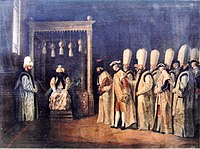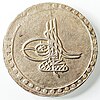Mustafa III
| Mustafa III | |||||
|---|---|---|---|---|---|
| Ottoman Caliph Amir al-Mu'minin Custodian of the Two Holy Mosques | |||||
 | |||||
| Sultan of the Ottoman Empire (Padishah) | |||||
| Reign | 30 October 1757 – 21 January 1774 | ||||
| Predecessor | Osman III | ||||
| Successor | Abdul Hamid I | ||||
| Born | 28 January 1717 Edirne Palace, Edirne, Ottoman Empire | ||||
| Died | 21 January 1774 (aged 56) Topkapı Palace, Istanbul, Ottoman Empire | ||||
| Burial | Laleli Mosque, Fatih, Istanbul | ||||
| Consorts |
| ||||
| Issue Among others | |||||
| |||||
Mihrişah Kadın | |||||
| Religion | Sunni Islam | ||||
| Tughra |  | ||||

Mustafa III (
Early life
Mustafa was born at the
Reign
Accession
Mustafa ascended the throne on 30 October 1757, after the death of his cousin Osman III, the son of Sultan Mustafa II.[5]
Character of Mustafa's rule
Soon after his accession to the throne, Mustafa demonstrated a special care for justice. He took a number of measures to increase prosperity in Istanbul. He regulated coinage, built large grain stores, maintained aqueducts, and established a strict fiscal policy.[6] He traveled frequently and checked whether the laws he had enforced were followed.[7]
Treaty with Prussia
Mustafa much admired Frederick the Great's generalship, and in 1761 established a peace treaty with Prussia. Frederick wanted an alliance against the Habsburgs, and Mustafa wanted to modernize his state and army. Mustafa preferred recruiting his officers in Berlin, rather than in Paris and London, to re-organize his army. In 1763, the two countries exchanged their diplomats for the first time.[8]
Russo-Turkish War (1768–1774)

Koca Ragıp Pasha, who remained grand vizier until 1763, pursued a peace policy towards neighboring countries. But the increasing influence of Russia over the Caucasus and its intention to control Poland created tension between the Ottomans and Russia. Ragıp Pasha's successor Muhsinzade Mehmed Pasha also preferred to remain at peace, and Mustafa's insistence on war ("I will find some means of humbling those infidels" [9]) with Russia led to his resignation in 1768. The Sultan expected to gain an easy victory over the Russians, but in fact the Ottomans were unprepared for a long war. During the war, military reforms were undertaken, with the assistance of French officer François Baron de Tott. They included the modernization of artillery corps and the foundation of the Naval Engineering School in 1773. The war was disastrous for the Ottoman Empire. The Russian armies occupied the Crimea, Romania and parts of Bulgaria.[10]
-
Russian forces charge against the Ottomans in the Battle of Kagul, southern Bessarabia, 1770.
-
The destruction of the Ottoman fleet in the Battle of Chesma, 1770.
Architecture
Many monumental buildings including the
Personal life
Poetry

He was a poet, his poetry being written under the pseudonym of Cihangir.[12]
"Yıkılupdur bu cihan sanma ki bizde düzele
Devleti çarh-ı deni verdi kamu müptezele
Şimdi erbab-ı saadette gezen hep hazele
İşimiz kaldı hemen merhamet-i lem yezele."[13]
(Translation)
"This world has ruined, don't even think with us it recovers,
It was the lousy fate that has delivered the power to vulgars,
Now the perfidious ones have populated the Imperial Palace,
It's now the mercy of the everlasting God that runs our business.
Family
Consorts
Mustafa III had seven known consorts: [14] [15] [16] [17] [18]
- Aynülhayat Kadın (c. 1746 - 1 August 1764). Probably BaşKadin (first consort),[19] is sometimes considered Mustafa's legal wife. She was the mother of at least one daughter[20] and had a sister, Emine Hanim, in the harem like her. She built the Katırcıham Mescid Mosque on 1760. She was buried in Laleli.
- Mihrişah Kadin (c. 1745 - 16 October 1805). She was of Genoese or Georgian origins, she was the mother of Selim III and two daughters. She was BaşKadin or became BaşKadin on the death of Aynülhayat Kadın.
- Fehime Kadın [21] (? - 1761). Mother of Reyhan Sultan, she died in childbirth.
- Rifat Kadın (c. 1744 - December 1803). Free-born woman, Mustafa met her while touring Istanbul undercover. She was then entrusted to the Grand Vizier's wife for educate her before entering the harem. Mother of Şah Sultan. After Mustafa's death, she returned to her family. She was buried in the Haydarpaşa cemetery.
- Ayşe Adilşah Kadin (c. 1748 - 19 December 1803). Of Circassian origin, she was the mother of two daughters. She was buried in the garden of the mausoleum of Mustafa III.
- Binnaz Kadın (c. 1740 - May 1823). Childless, after Mustafa's death she was married to Çayırzâde İbrahim Ağa. She was buried in the Hamidiye mausoleum.
- Gülman Hanim. BaşIkbal. Also called Gülnar Hanim.
Sons
Mustafa III had at least two sons: [22] [23]
- Selim III (24 December 1761 - 28 July 1808) - with Mihrişah Kadin. 28th Sultan of the Ottoman Empire.
- Şehzade Mehmed (10 January 1767 - 12 October 1772). His tutor was Küçük Hüseyn Ağa. He was buried in the Mustafa III mausoleum.
Daughters
Mustafa III had at least nine daughters: [24] [25] [26] [27] [22]
- Hibetullah Sultan (17 March 1759 - 7 June 1762) - with Mihrişah Kadin.Mihrişah Kadin, died, was his sister, Saliha Sultan, wife of the Grand Vizier, who presided over her Cradle Procession. At three months, she was betrothed to Hamid Hamza Paşah. In the luxurious ceremony, her father gave her the lands of Gümrükçü, but she died of illness at the age of three before being able to celebrate the marriage. She was buried in the Mustafa III mausoleum.
- Şah Sultan (21 April 1761 - 11 March 1803) - with Rifat Kadın. Of frail health, she was engaged twice, but both her fiancés were executed before the wedding. She eventually managed to marry and had two biological daughters and an adoptive one.
- Reyhan Sultan (1761 -?) - with Fehime Kadın. She died as a child.
- Mihrimah Sultan (5 February 1762 - 16 March 1764) - with Aynülhayat Kadın. Her birth was celebrated for five days. She was buried in the Mustafa III mausoleum.
- Mihrişah Sultan (9 January 1763 - 21 February 1769) - perhaps with Aynülhayat Kadın. Her birth was celebrated for three days. She was buried in the mausoleum of Mustafa III.
- Beyhan Sultan (13 January 1766 - 7 November 1824) - with Adilşah Kadin. She married once and had a daughter.
- Hatice Sultan (15 June 1766 - 1767) - perhaps with Aynülhayat Kadın.
- Hatice Sultan (14 June 1768 - 17 July 1822) - with Adilşah Kadin. She married once and had a son.
- Fatma Sultan (9 January 1770 - 26 May 1772) - with Mihrişah Kadin. She was buried in the mausoleum of Mustafa III.
Death
Mustafa died of heart attack[29] on Friday,[30] 21 January 1774,[30][31][32] at the Topkapı Palace, and was buried in his own mausoleum located at Laleli Mosque, Istanbul.[33] He was succeeded by his brother Abdul Hamid I.[34] His death left the empire struggling with economic and administrative problems.[35]
-
Laleli Mosque tomb Sultan Mustafa III and son Selim III
References
- ^ Brill, E. J. The Encyclopaedia of Islām: A Dictionary of the Geography, Ethnography and Biography of the Muhammadan Peoples, Volume 3, Part 2. p. 761.
- ISBN 978-1-850-43760-4.
- ISBN 978-1-441-10251-5.
- ^ Keskiner, Philippe Bora (2012). Sultan Ahmed III (r.1703-1730) as a Calligrapher and Patron of Calligraphy. p. 58.
- ISBN 978-8-130-70390-9.
- ^ a b Ágoston & Masters 2009, p. 411.
- ^ Sakaoğlu 2015, p. 334.
- ISBN 978-1-935-29572-3.
- ^ Lord Kinross Ottoman centuries
- ISBN 978-1-461-73176-4.
- ^ Sakaoğlu 2015, p. 343.
- ^ Lord Kinross, Ottoman Centuries, (Perennial, 2002), 406.
- ^ Yıkılupdur bu cihan sanma ki biz de düzele
- ^ Beydilli, Kemal (2020). Kitab-ı Hedaya, Studien zum Osmanischen Reichundseinen Nachbargebieten, III. Mustafa (1757-1774): Kaynarca Öncesi Bir Padişah Portresi. Press of the University of Bonn. p. 233 n. 211.
- ^ Ulçay 2011, p. 149-151.
- ^ Kal'a, Ahmet (1998). Istanbul külliyâtı: Istanbul tarım tarihi, 1 (1743-1757), 2 (1757-1763). Istanbul Araştırmaları Merkezi. p. 218.
- ^ Haskan, Mehmed Nermi (2008). Eyüp Sultan Tarihi - Volume 2. Eyüp Belediyesi Kültür Yayinları. p. 583. ISBN 978-9-756-08704-6.
- ^ Sak, Osman; Çalışkan, İrfan (2002). Beşinci Eyüpsultan Sempozyumu. Eyüp Belediyesi Kültür ve Turizm Müdürlüğü. p. 124. ISBN 978-9-759-38441-8.
- ^ Esad Efendi believed she was the third consort. It is possible that she was demoted in favor of Mihrişah Kadin when she had a son.
- ^ She was the mother of Mihrimah Sultan, and according to Oztüna also of Hibetullah Sultan, Mihrişah Sultan and Hatice Sultan (the one who died as a newborn). However, the plaque on her grave only identifies her as Mihrimah's mother, and it has been discredited that she was Hibetullah's mother, while her other two daughters remain uncertain
- ^ O Fehime Hanim
- ^ a b Şemʼdânî-zâde Fındıklılı, Süleyman Efendi (1976). Aktepe, M.Münir (ed.). Şemʼdânî-zâde Fındıklılı Süleyman Efendi târihi Mürʼiʼt-tevârih-Volume II A. Edebiyat Fakültesi Matbaası. pp. 32, 50, 65, 95.
- ^ Şemʼdânî-zâde Fındıklılı, Süleyman Efendi (1976). Aktepe, M.Münir (ed.). Şemʼdânî-zâde Fındıklılı Süleyman Efendi târihi Mürʼiʼt-tevârih-Volume II B. Edebiyat Fakültesi Matbaası. pp. 24, 89, 90.
- ^ Uluçay 2011, p. 151-158
- ^ Sakaoğlu 2008, p. 466-483
- ^ İyianlar, Arzu (1992). Vâlide Sultanlar'ın İmar Faaliyetleri. İstanbul Üniversitesi Sosyal Bilimler Enstitüsü. pp. 167–8, 170–71.
- ^ Dominic, Paulina D .; Roszak, Stanisław (2017). The Istanbul Memories in Salomea Pilsztynowa's Diary "Echo of the Journey and Adventures of My Life" (1760). pp. 52 n. 41.
- ^ According to Oztüna, her mother was Aynülhayat Kadın, but this information was discredited
- ISBN 978-0-571-27908-1.
- ^ a b Sakaoğlu 2015, p. 346.
- ISBN 978-0-199-87430-9.
- ^ The Biographical Dictionary of the Society for the Diffusion of Useful Knowledge Vol. 1 Part II. 1842. p. 523.
- ISBN 978-1-843-53071-8.
- ISBN 978-1-108-02065-7.
- ^ Ágoston & Masters 2009, p. 412.
Bibliography
- Ágoston, Gábor; Masters, Bruce Alan (2009). Encyclopedia of the Ottoman Empire. Infobase Publishing. ISBN 978-1-438-11025-7.
- Sakaoğlu, Necdet (2008). Bu mülkün kadın sultanları: Vâlide sultanlar, hâtunlar, hasekiler, kadınefendiler, sultanefendiler. Oğlak Yayıncılık. ISBN 978-9-753-29623-6.
- Sakaoğlu, Necdet (2015). Bu Mülkün Sultanları. Alfa Yayıncılık. ISBN 978-6-051-71080-8.
- Uluçay, Mustafa Çağatay (2011). Padişahların kadınları ve kızları. Ankara: Ötüken.
External links
 Media related to Mustafa III at Wikimedia Commons
Media related to Mustafa III at Wikimedia Commons






